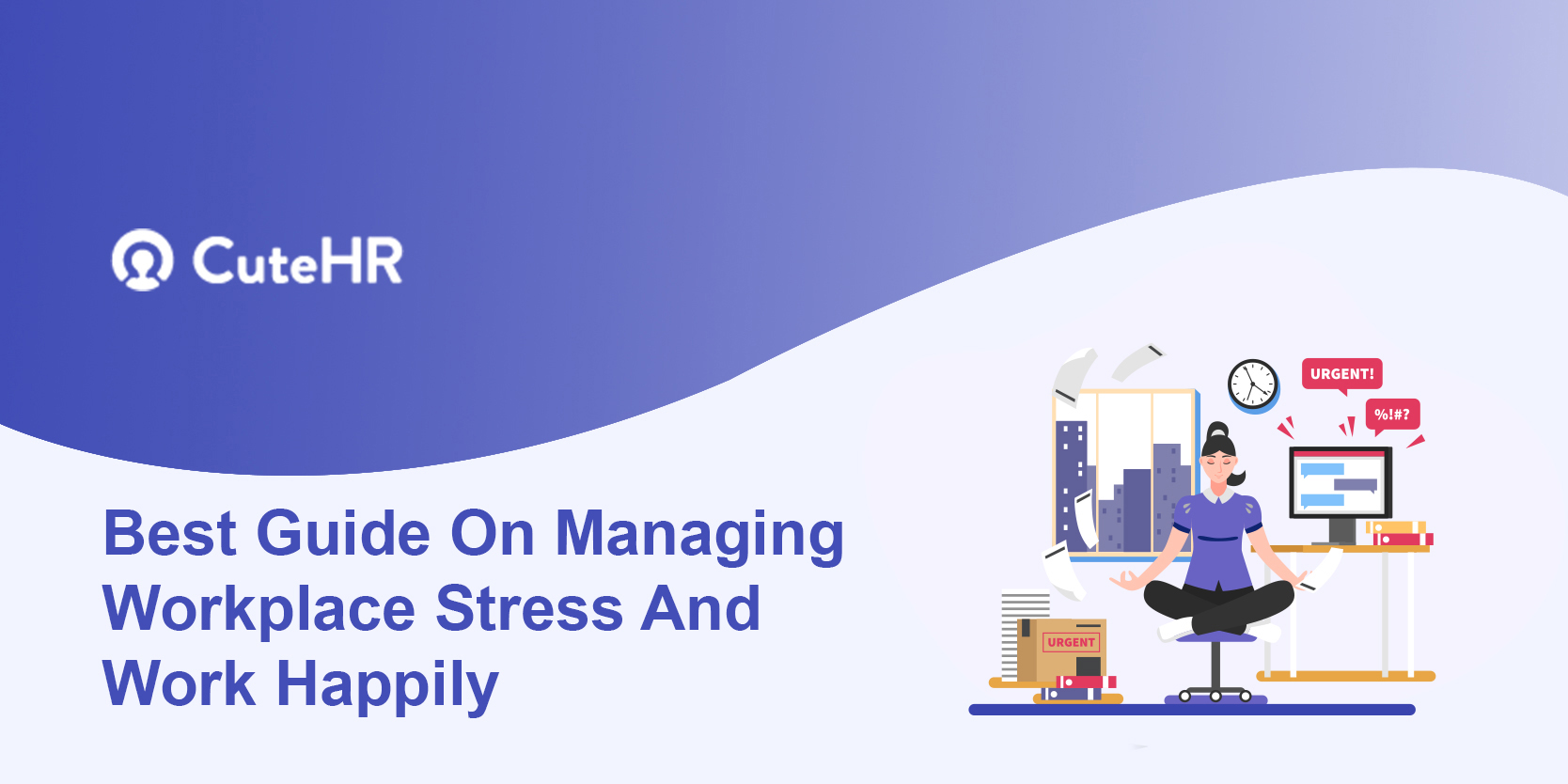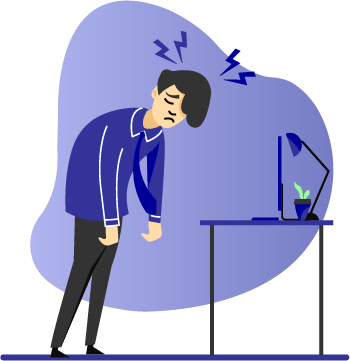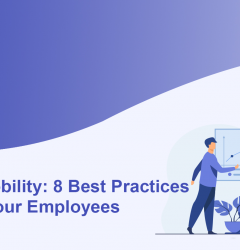18 Feb

It is a task to maintain mental well-being in times where work and stress are synonymous to each other. Every job requires undivided attention and sincerity. Alongside, inevitable circumstances pile on to make a work ten times more hectic. Hence, managing workplace stress has become quintessential.
Innumerable studies and research blame job-related pressure as the major contributor to stress. It is not only the duty of the employees but also of the management to tackle a stressful work environment.
In the long run, this paves the path for job satisfaction, improved performance, increased dedication among other benefits.
Table of Contents
Alarming Stress Statistics

One-fourth of the employees surveyed found their jobs to be the major cause of stress.
As per a survey conducted by Northwestern National Life,
Job stress has surfaced as the leading cause of mental pressure. Consequently taking a tax on an employee’s personal life, physical and emotional well-being. Its harmful implications are numerous and can develop into serious diseases too.
77% of Americans display physical symptoms of stress, while 73% undergo it’s various psychological vulnerabilities.
Reports by The American Institute of Stress
Fortunately, there is now a rising awareness regarding such a sensitive yet common topic. For the same, April is considered as the Stress Awareness Month. Alongside there are strategies devised to manage workplace stress too. To effectively conquer stress there is a need to –
- closely analyze job stress,
- highlight the visible red flags,
- common causes and symptoms
- find a cure
- develop coping strategies
Workplace Stress – Causes and Symptoms

Without a doubt, stress is the most commonly heard of disorder these days.
In layman’s language stress is simply the psychological torment one goes through in dealing with unexpected or difficult circumstances, situations, and tasks. It is purely self-generated and can be triggered from external factors. Stress has implications on the body and mind which are sometimes invisible and other times veiled. This earns it the reputation – silent killer.
To get ahead of such mental torment, HR managers can step in and take drastic measures. Besides facilitating employee-employer relationships for smooth organizational function, HR managers should keep an eye out for unwanted tidings of stress. Many times the most difficult situations can be sorted by discussing it out.
Various reasons for stress can stem from organizational, individual, physical, and interpersonal factors. Everyone who is a part of an organization must feel free to communicate in times of need and seek help if things go beyond control. A dedicated HR department can become a host to such facilities, to make workers feel safe and heard.
Briefly, employees and managers can encounter stress due to-
- Difficult projects,
- Excessive workload
- Lack of control and social support
- Tricky deadlines,
- Competition,
- Overlooked hard-work
- Long work hours
- Lack of necessary infrastructure
- Lack of clarity, vision, guidance and growth opportunities
- Unmanageable teams and goals
- Unachieved targets
- Unstable market performance
- Rigid rules and regulations
- Stringent policies.
An additional promoter of a stressful environment can be –
- Internal fight or existing rivalries between colleagues, subordinates or executives
- Feeling targeted
- Harassment
- Instability
- Feeling of inferiority
- Unsuitable working conditions
- Toxic or hostile work environment
- Peer pressure
- Health problems
- Personal life issues
With such common triggers, stress can easily be transferred from one level to the other. Therefore, managing workplace stress becomes an even more urgent issue.
But positive workplace stress functions as a necessary boost, offering a motivational nudge in the achievement of goals and targets.
In fact, more than often, managers and employers fail to understand employee inhibitions and limits, leading them to experience work-related pressure.
Mental stress and storm are bound to have unwelcomed upshots. Only with its early detection prompt measures can be taken for managing workplace stress.
Indicators of Workplace Stress
A workforce under incredible stress will always be counterproductive. A diligent manager or HR team should employ efficacious measures to control and pacify their work environment.
Managers should stick to McClure’s point of view on the situation, “The welfare of employees has a direct impact on the success of the company, and it is in everyone’s best interest to improve their well-being and job satisfaction.”
The practice of empathy by managers propagates positivity and improves interpersonal relations.
Hence, it is needed to look out for a few common indicators of a stressful work environment –
- Irritated or Rude Employees – It is the most commonly intercepted red flag of persisting job stress. Snappy, edgy, angry, or frustrated employees point towards an unsatisfied workforce or extra work pressure.
- Taking too much or too fewer beaks – If employees are always rushing to get done with lunch or snack breaks, it surely is unhealthy. Moreover, running away from work by ignoring it through frequent escapism, in the form breaks is also a stress indicator.
- Absenteeism – Absenteeism is synonymous with escapism. The underlying cause for taking too many leaves or an unpunctual attitude can be stress.
- Employee Turnover – If employees are subject to grueling projects, rigidity, and a tensed environment, they are bound to quit; earning the organization a bad reputation for being insensitive to its employees. The employee turnover rate would show a downfall. Workplace stress management demands the humane treatment of employees in a conducive environment.
- Declining health standards – Stress takes a toll firstly on the physiological well-being and then latches onto the health. If employees complain of deteriorating physical or mental health, it is advised to monitor the stress levels.
- Alcohol or Drug Abuse – As a coping strategy, people are inclined to resort to drug and alcohol abuse. Frequent cigarette breaks and alcohol consumption is a definite red flag.
- Loss of concentration and Interest – Tension can also take the form of low concentration level or a feeling unmotivated.
- Underperformance – If your employees are constantly submitting incomplete and obsolete work or show signs of incompetence, it is high time to reassess your strategies and communicate to figure out the underlying problem. Often stress causes inefficiency which is visible through work.
Apart from these common indicators, stress can pervade in day to day employee activities. Therefore one must keep an eye out for such visible stress symptoms.
Why Bust Stress?

A stress-free environment promotes –
- Workplace positivity
- Increased retention
- Enhanced productivity and results
- Better and transparent communication
- Smoother employee-employer relationships
- Better employee treatment
- Inculcation of opportunities
- A feeling of self-confidence and trust
Without a doubt, stress does more harm than good if not properly contained. It surely has psychological and physical effects. Moreover, it’s existence in every sphere of life is alarming. Managing workplace stress is a healthy habit, with long term positive consequences both for the company and its employees.
Strategies For Managing Stress In The Workplace
There are comprehensive strategies to adopt when dealing with stress in personal or work life. Both employees and managers can stick to these effective measures and incorporate them into their personal and corporate domains respectively.
1. Monitoring :
Most times stress goes unnoticed but feeds on your body and mind like a parasite. Therefore, a regular peep into your individual and work-life gives a necessary insight. One must keep tabs on the stressful elements and dig in deep to chalk out their root cause. Stress and its consequences are different for each person. The first strategy for managing workplace stress is to understand it’s existence, it’s nature and accept it.
This first step requires a profound understanding of oneself. Many may find this concept alien. But knowing the self is the key to unlock mysteries of the body and mind. There are simple ways to begin with.
(a) On An Individual Level –
- Practice meditation
- Ask yourself questions
- Be honest to yourself
- Monitor your moods
- Inspect your daily routine for stressful elements
- Track your behavior patterns and reactions.

All these methods listed above offer an edge and lets you understand your stress levels.
The managers must assess the stress levels of their employees and equip them nonetheless. There are methods that can be employed for managing workplace stress.
(b) On An Organizational Level –
- Counseling and discussions
- Monitoring employee behavior
- Tracking employee breaks, absenteeism, and physical health
- Holding interactive workshops
- Social detoxification
- Conducting recreational and team building activities

2. Understanding :
Post successful monitoring of stress, it is needed to dig deeper to pluck out its cause. If you are able to spot a stressful component in your workplace or personal life, demarcating its cause becomes quintessential.
(a) If employees convey a certain project or situation as stressful,
Genuine steps must be taken to provide for a more facile environment. Overburdening employees with projects, deadlines, and overwhelming circumstances can spike unwanted stress levels. A manager must be perceptive in his approach so as to apprehend each employee’s strengths and weaknesses.
This will give him an edge in designing and attributing responsibilities and save him from setting unrealistic expectations. Identification of stress causative agencies makes for one of the most effective workplace stress management strategies. Moreover, personal cognizance of employees makes it easier to spot stress strains.
(b) To understand stress at an organizational level, communication becomes key.
There should be the needed transparency to avoid ambiguity. In fact, communication should promote a feeling of belongingness and being heard. The employees should be comfortable reaching out to communicate any stressful circumstances they are under. An organization should aim to promote healthy co-worker relationships and the presence of a concerned, humane organizational body.
(c) On a more personal level, everyone should practice mindfulness.
The art of being mindful alerts the self about any faint stress signals. Mindfulness becomes a weapon nonetheless and instills awareness regarding stress and its causes. As a matter of fact, each individual reacts differently under stress.
A combination of factors – physical, psychological, and environmental, react to produce a unique individual response to stress.
On a subconscious level, practicing the art of mindfulness can help one to gain access to his psychological functioning.
The World Health Organization (WHO) opines workplace stress to subsist when employees lose clarity, lack knowledge, find work or managers to be overbearing and in a deficit of managerial and peer support.
3. Resolving
Management is obligated to withdraw its employees from the clasps of stress and come up with a resolve. For this, any problematic situation, task, and deadline needs to be cooperatively dealt with. A feeling of sharing responsibility makes it easier to cope. Ideally, the human resource management conveys the ground reality to the superiors. Therefore, it is their foremost responsibility to report any existing employee crisis due to stress or trauma.
Organizational Strategies for Managing Workplace Stress
Provisions must be made to facilitate employees with tools and strategies that they can employ in a stressful situation.
With contrivances like-
- Communication,
- Planning,
- Delegation and
- Outsourcing, stress can be analyzed.
A definite solution can be reached thereafter.
- An organization culture, dealing with a tense environment can dig into its policies, recent changes made, management strategies, and projects to look for a stress trigger.
“It’s important for managers to spot the signs of stressed-out employees, such as incomplete work, decreased productivity, lower quality of work and mistakes”.
Mike Steinitz, executive director for Accountemps
Both employees and managers can reduce the hassle of team management by relying on remarkable tools. One such automation tool is our CuteHR. This tool is a boon as it facilitates remote as well as in house management of human resources.
It’s carefully curated features given below provides all-round facilitation in monitoring employees and makes project management smoother-
- It has multiple project management facilities.
- CuteHR provides designated space for each individual client as well.
- The added benefit of a free time tracker allows employees to track time for productive and unproductive hours.
- An efficient attendance and leave management system makes CuteHR a holistic manager.
- A much-needed feature of invoice creation and payroll also exists in the ingenious CuteHR project management tool.
The presence of such streamlined systematic tools greatly contributes to the smoothness of any management. Consequently, workplace stress becomes negligible and easily resolved.

Individual Strategies for Managing Workplace Stress
Everyone should keep track of their own stress levels as a positive practice. Working in such inevitable times, it becomes necessary to devote time to oneself. Here, being mindful comes in handy along with these few tips –
- Organize – Any work can transform into a pile of stress if it is left unorganized. Sorting and organizing work or decluttering has a positive psychological effect and reduces stress levels.
- Plan – Scheduling tasks, projects, chores and meetings facilities time management and a clear vision. Reflect on your task and search for the most doable way to plan them.
- Prioritize – Excessive deadlines can drain your energy. It is best to prioritize office work and proceed with their completion accordingly.
- Pause – The secret to attain zen at a workplace, is to know when to pause. Working for long hours overexerts the body and mind. This leads to burnout and can show other harmful results.
- Evaluate – Every now and then there is a need to evaluate and re-evaluate your work strategies. This brings out any existing gaps in planning and organizing. Stress can be caused due to these gaps.
- Reach out – Bottled up tension and stress can take an ugly turn, causing troubles for the mind. Having a confidante or someone to talk serves as a way to vent out and many times provides a solution. A friend, parent, partner, guide, mentor, sibling, counselor or colleague can become a stress buster.
As per Clinical Psychological Science,
“Providing help to friends, acquaintances, and even strangers can mitigate the impact of daily stressors.”
- Listen to your body – The body communicates in its own way. Being mindful allows an individual to listen and act accordingly. Turning into a workaholic won’t prove healthy as the body demands necessary movement.
Increasing Awareness
A powerful weapon in the arsenal for managing workplace stress is to spread awareness about it. Most employees endure stress without knowing it’s sly presence and associated dangers. Not only should people at a workplace be equipped to manage stress, but should positively be sensitized to its presence among their colleagues and social groups. Here are some effective methods to spread stress-related awareness –
- Organizing stress management workshops and webinars,
- Conducting regular wellness programs,
- Promoting mindful activities like yoga, sports, and meditation
- Encouraging employees to pursue hobbies, network, build a social life, and create a family-work life balance is a dedicated path that organizations can adopt.
All in all, an organization has to impart and adopt effective coping mechanisms, combined with relaxation techniques for holistic employee welfare.
Organizations like TCS have a devoted helpline and mailbox facility for its global branches. Here employees can communicate to get help in personal matters, work-related issues, any hindrances or obstacles encountered, workplace or managerial inefficiency, etc.
Such organizational disposal is exemplary and communicates employee safety as a prime concern.
Managing Stress at Workplace Post Covid
Stress at the workplace has a new definition now. The people and workforces who were working remotely need to get back to their workplace in order to maintain the continuity of the country’s economy. The situation is not yet controlled but we need to pace up with jobs to keep the businesses surviving. Under such a situation, the stress while working from workplaces is also impactful.
We are sharing some ways through which it will become easier to managing workplace stress post covid.
- Maintain the social distancing formula in the workplace.
- Allow your resources to work in shifts so that you can rotate your team with the least gathering at a single time shift.
- If possible, the organization should arrange for special suits to be worn inside workplaces or make it a compulsion to wear suits that covers the body entirely.
- Gathering at breakpoints should be avoided.
- Using disinfectant and sensitization alarm should be set up at workplaces.
- All employees should be checked with their body temperature before entering office premises.
- Share good news via email related to Covid recoveries worldwide. This will create a positive feeling among people working at workplaces.
Is your organization using any new smart way to reduce workplace stress during this pandemic? Share with us in the comment so that other organizations can also implement them. We all need to share the best ways so that we can save the economics globally.
Conclusion
Stress has become the necessary evil haunting workforce and the management equally. Prompt and productive measures towards its eradication must be at the apex. On an individual and institutional level, undue attention has to be given to managing workplace stress. Employees can make use of planned maneuvers and tips listed above under any unforeseen circumstances.













Avneet Oberoi